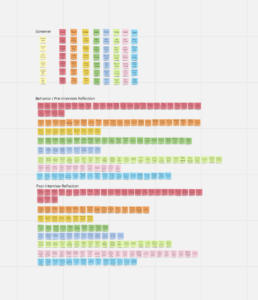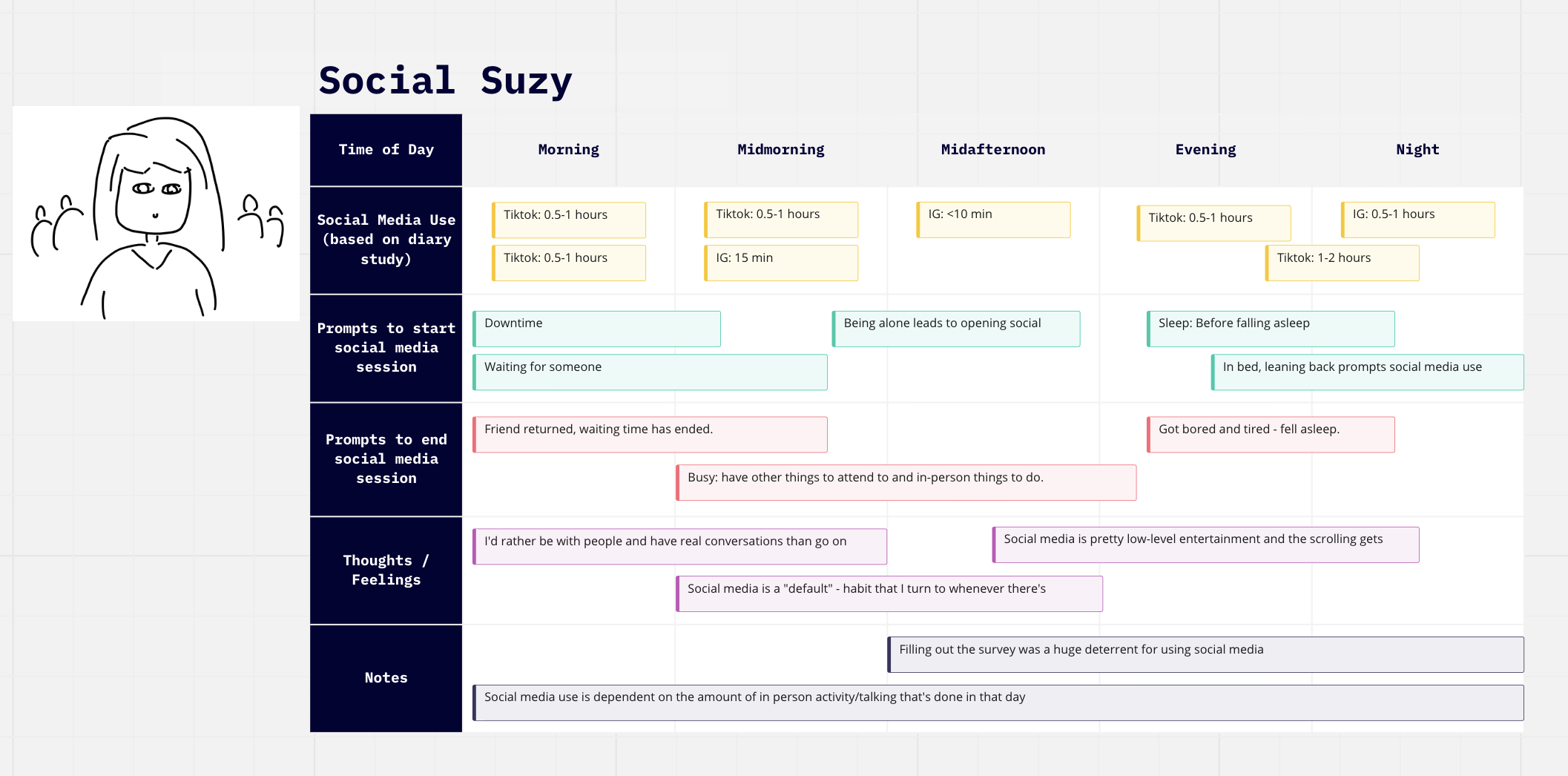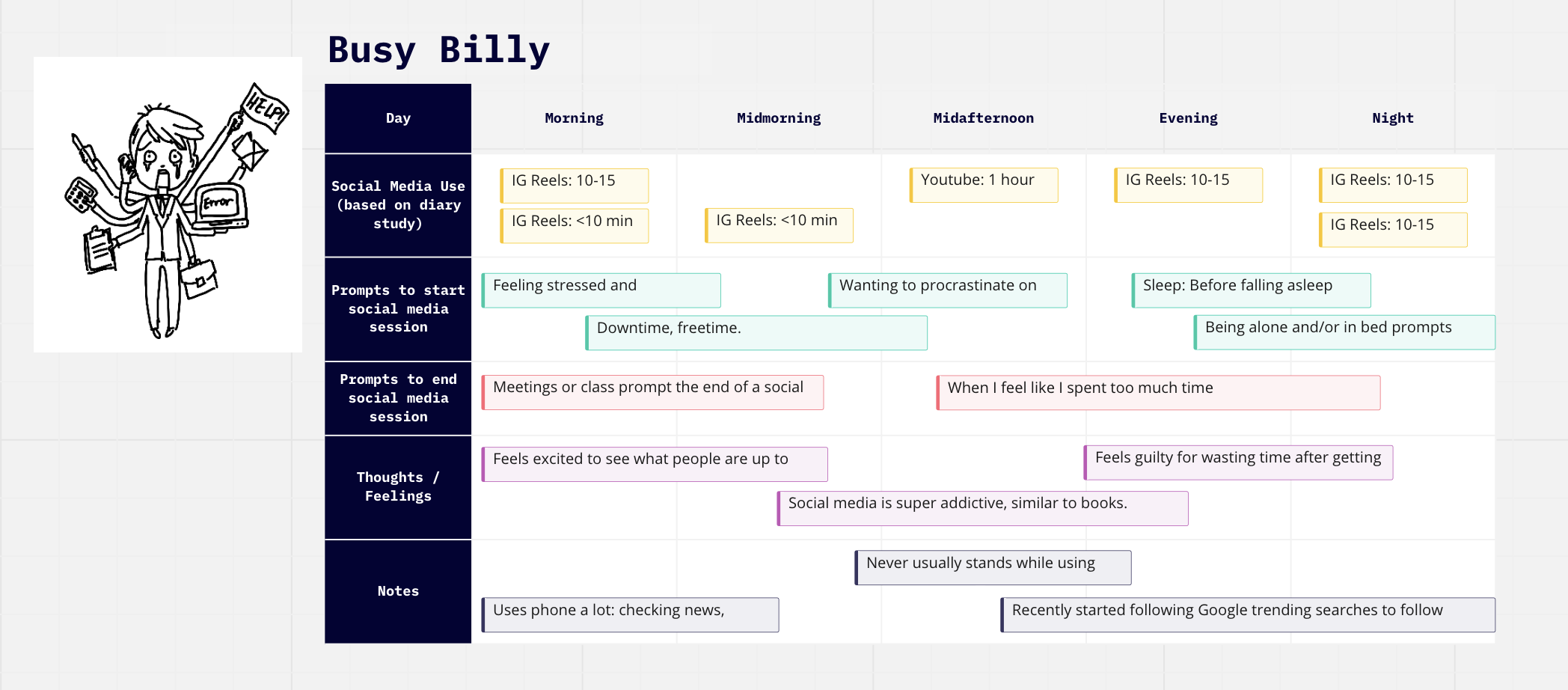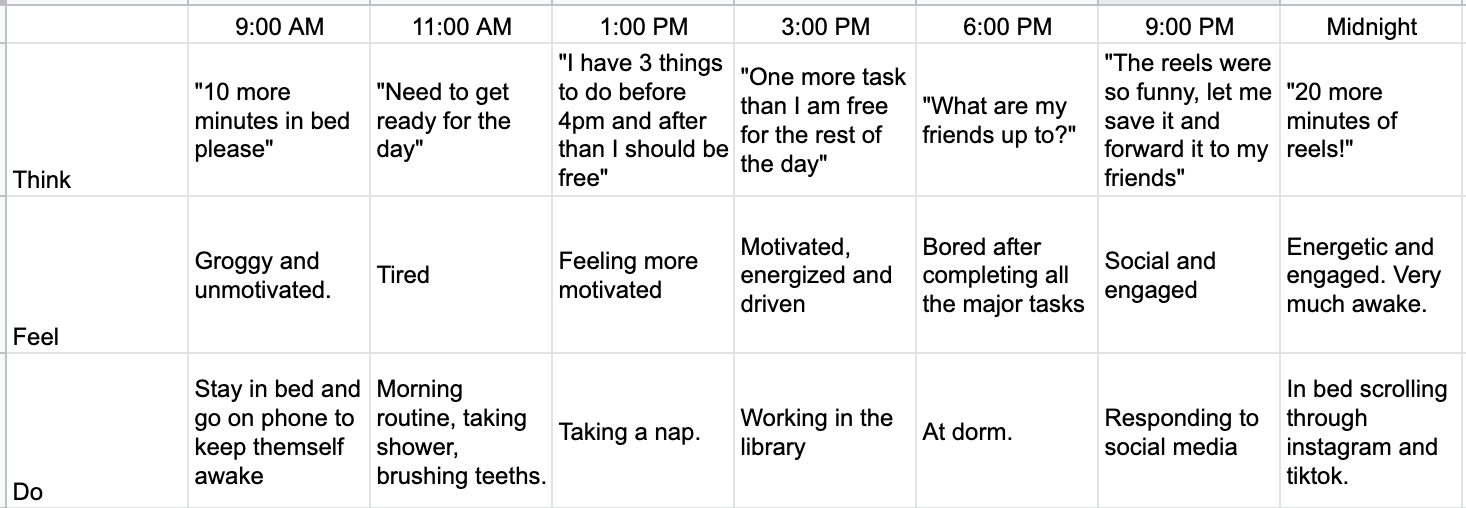🧠 Synthesis Process
We began synthesizing our data by fragmenting all of our raw data— pre-study interviews, baseline studies, post-study interviews—into stickies so we could begin processing our data and finding patterns through various forms of grouping and mapping. To start fragmenting our data, we simply started writing down one piece of information per sticky, while making sure to note anything that was surprising, as well as any user pains and joys.

After having all of the user data laid out, we could begin affinity mapping—where we began to group any sticky notes that seemed similar. Affinity mapping helped us begin to take note of any patterns, such as how many of our participants would avoid opening IG reels in public. Once we finished affinity mapping, we could move onto frequency mapping where we more formally categorize the stickies by various actions and emotions, thus allowing us to find out which feelings were greatest or most frequent, which actions or settings most coincided with opening a social media app to scroll, etc. Frequency mapping enabled us to see which categories had the most data and were therefore the most “important” for us to think about.
After going over the users we studied and their scrolling habits, we narrowed our findings more concisely through a connection circle, fishtail diagram, mind map, and causal loop.




👨👩👧👦 Proto-Personas and Journey Maps
| Name of persona:
Working Will |
Project | Team 10 – Claire Muscat |
| Role | Recently graduated student-athlete (golfer) working at the mall in a shop for sports simulations | |
| Goal | Wants to reduce screen time after seeing friends’ lower screen timer → social pressure
Wants to use time for more productive things such as reading |
|
| Motivation | Feels like he’s wasting time on social media
Feels called out / judged by friends with lower screen time |
|
| Conflict | A lot of downtime at work + ease of use makes it hard to get out of the habit of overuse
Short-form content is SO easy to consume → there’s always more |
|
| Attempts to Solve | Tried to reduce screen time during golf season by turning the phone off while at practice or tournaments (normally would go on phone while waiting or walking the course). Saw lower screen time in general, but only lasted during golf season → when season ended, phone usage / social media usage went back up to normal levels | |
| Setting/ Environment | Often go on it at work during downtime (majority of time)
Sometimes go on at home or in car when waiting for people Would go on during round of golf / in-between holes |
|
| Tools | Accountability with other friends
Turning phone off Deleting app |
|
| Skills | Having alternative ways to spend time → like reading a book | |
| Routines | Downtime at work between customers
Waiting for people Check notifs when waking up / before sleeping |
|
| Habits | Scroll when bored and scroll until bored or tired
Sending and receiving funny videos Feeling bad about using social media so much |

| Name of persona:
Social Suzy |
Project | Team 10 / Christina Kwak |
| Role: | Student with too much time on their hands | |
| Goal | I want to stop going on social media | |
| Motivation | because I want to spend my time more productively. | |
| Conflict | I’m used to going on social media when bored | |
| Attempts to Solve | I’ve tried uninstalling the app but I get bored again and redownload it.
Having to fill out the form really stopped me from using social media. This week was a weird week so my social media consumption was off |
|
| Setting/ Environment | Usually alone, on my bed. | |
| Tools |
|
|
| Skills |
|
|
| Routines | Before I sleep, when I wake up I go on my phone
Whenever I have downtime I go on my phone |
|
| Habits | Scrolling through social media is unconscious. |

| Name of persona:
Busy Billy |
Project | Team 10 / Christina Kwak |
| Role: | Stressed out student | |
| Goal | I want to reduce social media use | |
| Motivation | Because I feel like it eats up all of my time | |
| Conflict | Social media destresses me and I get excited by the idea of going on and checking what people have been up to | |
| Attempts to Solve | I’ve tried to use screen time limits but seeing how high my screen time is was stressing me out so I stopped. | |
| Setting/ Environment | I go on when I’m procrastinating or have free time and usually get off when there’s an immediate thing to attend to (ie. meeting or class) | |
| Tools |
|
|
| Skills |
|
|
| Routines | Downtime, time between classes, etc are all usually used for social media. | |
| Habits | I feel connected to people when I check their socials. |

| Name:
Bored Bob |
Project | Team 10 – Hyunseok Hwang |
| Role: | Undergraduate student who is taking lower units than their friends | |
| Goal | Motivated to spend less time on social media and on reels.
Better time management and improve productivity! |
|
| Motivation | Feels bad when reviewing screen time.
Feels that they could be doing more with their time at Stanford. |
|
| Conflict | Instagram reels and tiktoks are easy to access and allows instant gratification.
To make other plans, they feel that they need to commit, while instagram reels does not need commitment. |
|
| Attempts to Solve | Actively setting screen time limits for certain applications.
Having a separate account on instagram and tiktok. Does not trust third party apps to do a good job and also does not want to spend extra cash. |
|
| Setting/ Environment | After lunch time.
Before going to bed. When there is an excess of 10-15 minutes, they will jump on. Responding to friend’s instagram DMs. Anything that instigates boredom triggers going on phone and consuming short-form contents. |
|
| Tools | Deleting the application.
App store accessibility. |
|
| Skills | Time management skills.
Journaling. Retrospective thinker. |
|
| Habits | Sleeping problems. Irregular sleep schedule.
Goes on phone before going to bed. Checks phone home screen(“pick up”) multiples times throughout the day. |

🏆 Gamification (Harnessing Power of Social Dynamics)
For this intervention, we will harness the power of social pressures and the fact that humans care very much about how they and their actions are perceived by others and how they are judged by societal norms of “good” and “bad”. Each participant will be told that they are competing with the other study participants to see who can have the least amount of screen time and time spent on social media apps. They will be notified of their supposed “ranking” each morning. The rankings sent out will be fabricated and will be the same for each participant. Over the course of the five days, we want to observe the effect of competition and gamification on the use of social media and better understand if it has the power to influence screen usage and habitual scrolling.
Pros:
- Social pressures and perception in the eyes of others was a recurring theme and an underlying factor driving the desire to change screen time usage. This option harnesses this factor that is consistent across participants and very influential.
- Gamification allows for positive framing of the problem of deadlock scrolling and attempts to correct this behavior as opposed to interventions that attempt to utilize negative tactics (such as shaming or scare tactics via stats).
Cons:
- Gamification will only be effective if the participants care about what others think about their screen time. Although we found this to be a common occurrence, it is not universal, and the social pressure can only inspire so much change if the individual actually cares about their self-perception in regards to screen usage.
- Additionally, gamification doesn’t work in the scenario where the individual doesn’t view their screen time as a problem (even if it is high).
- This is too short-term of a solution. Games and competitions are highly effective for a short period of time but the allure and fun wears off quickly and is difficult to sustain.
Generate alternatives (Harnessing Power in Alternatives)
When a user attempts to open an app with short-form content, before the app launches, the user will be prompted with two options: 1) Waste time scrolling! and 2) Try something new! If the user clicks the first option, they will go into the app as intended. However, if they click the second option, they will be given a list of potential alternatives to scrolling aimed at providing relief from boredom but preventing hours of mindless scrolling such as interesting poems to read, puzzles to solve, journal prompts, a new song to listen to, or a prompt to spend the time reaching out to a loved one. After analyzing the interviews and the data from the baseline study, we found that scrolling sessions often come about as a filler for downtime or during boredom. This intervention attempts to give users engaging alternatives to the habit of endlessly scrolling when bored; these alternatives would ideally be less addictive to prevent excessive scrolling
Pros
- The alternatives that can be suggested can be less addictive than social media and therefore prevent deadlock scrolling while still facilitating entertainment for the user.
- The alternatives generated would also be a more productive use of time as compared to time spent during scrolling.
- The feeling of scrolling through endless videos could be simulated through the idea generator and thus still create a similar feeling that scrolling produces without the scrolling itself.
Cons
- Screen time itself won’t necessarily be diminished since the alternative will be digital in nature and has the potential to be addictive.
- Social media has a foothold in society and is very addicting for a reason – it allows for entertainment at any time without much thought or friction. This idea might cause user friction if the initially generated ideas aren’t liked and thus not create the same high from social media.
Make the person get up and move (Harnessing Power in Environment)
This intervention would make use of personalized scrolling limits and gyroscopes. Each individual would set a “scrolling time limit” for specific applications. Once the user reaches that amount of time scrolling on the app, the app would lock and would require the user to move a specific amount of feet before being able to resume scrolling. Overall, this idea targets the influence of environmental factors on scrolling habits and phone usage.
Pros
- Forced movement doubles as a prompt for a potential alternative of physical activity and a change in environment.
- Our interviews revealed that the universal body position during a longer scroll session is sitting or laying down in a comfortable position. This intervention requires movement which disrupts comfortable scrolling positions and can thus break the scrolling session.
- Environmental factors are powerful and act as triggers or prompts, so changing a person’s environment (even if it is simply a room change) can provide prompts to stop scrolling or provide other stimuli that are more appealing than scrolling.
Cons
- This idea is potentially very annoying for end users which might lead to low retention.
- Additionally, this idea is easy to bypass and thus not be effective. It is easy to move slightly and assume another comfortable position in a different room and continue scrolling.
Intervention study
People:
- Tyler Ho (old)
- Colby Gunderson (old)
- Matthew Murata
- Kevin Chen (old)
- Derek Huang (old)
- Jean Chun (old)
- Rachel Ludwikowski
- Glennis Murphy
Intervention Plan:
- Gamification (ST motivation), social pressure (LT motivation)
- Daily leaderboard (ideally in app but we’ll do a text day by day) – mb send a figma screenshot showing winning being taken away
- Day 1: first place
- Day 2: first place (streak)
- Day 3: first place, warning about close second place (streak)
- Day 4: second place, overtaken by 2nd place (breaks streak)
- Maybe say the second place person beat them by 10 min less than their screentime
- Day 5: see what happens to screentime today
Data Collected:
- Daily screenshots of screen time
- Only the last one will be
Drawbacks:
- Too short term
- Requires similar motivations from participants
- Social pressure is easier w friends but we don’t have that rn
Hypothesis:
- Day 5 social pressure/gamification will lead to wanting to win -> less screentime
- Will they work hard to get back to 1st place?
Questions:
- How did you feel about the 5 day study?
- How did you feel at the end of each day when you got your screentime ranking?
- How did you feel at the beginning of each day in regards to screentime?
- Did the ranking change your behavior?
- Did you choose not to go on social media in order to reduce screentime at any point? And why?




Comments
Comments are closed.